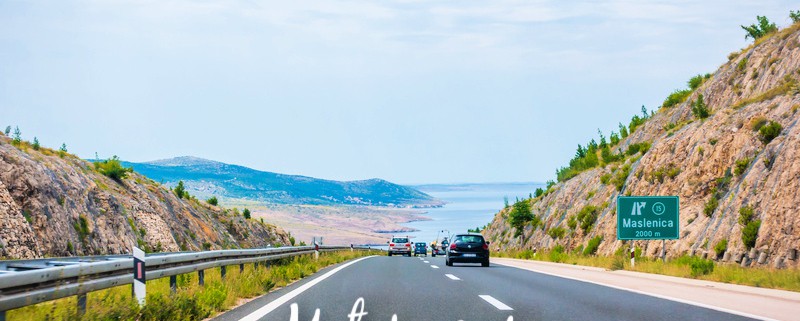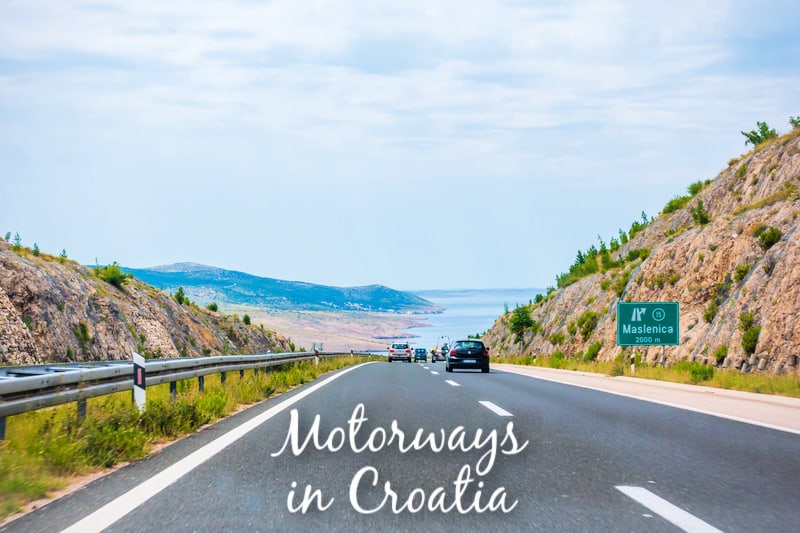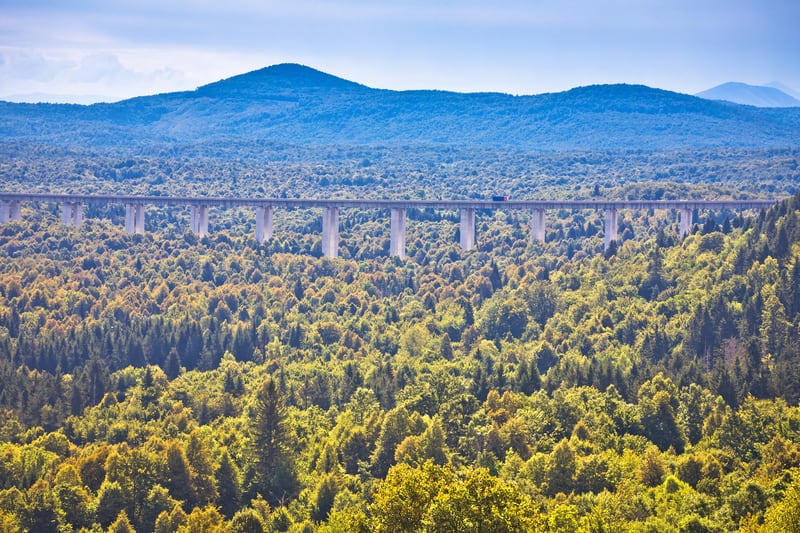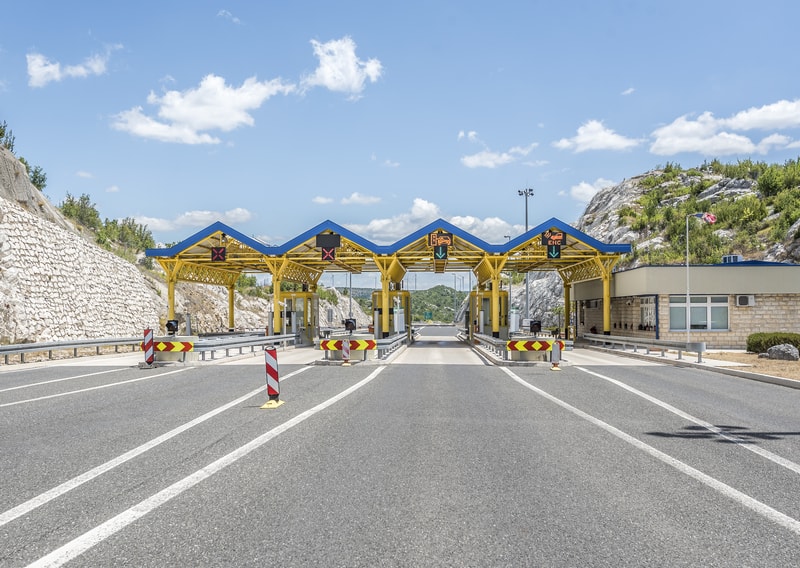
If you’re exploring Croatia with a hire car (or perhaps with your own car, having driven to the country), you will likely be using the motorway network to travel around the country. (Or the highway network for our American friends!) This section will take a look at motorways in Croatia, where you travel around in Croatia using them, how to use the toll system and more.
In 2023, the World Economic Forum placed Croatia 12th (out of 141 countries) for best road infrastructure in the world.

Motorways in Croatia
Motorways – or highways (or autoceste in Croatian) – in Croatia were largely constructed in the 2000s, after Croatia’s independence in the 1990s and the homeland war that ended in 1995. There were, however, small parts of motorway already in existence in the country with small sections built in 1950s, and the 1970s and 1980s. One such section is part of today’s A3; this used to be the “Brotherhood and Unity Highway” that connected Ljubljana in Slovenia with Zagreb, Belgrade in Serbia and Skopje in North Macedonia.
Today in Croatia, there are eleven motorways in the country and all are designated as an ‘A’ road on the part of the general road network.
You may also find some of the motorways labelled on maps with an ‘E’ designation – this means they are part of a European route, which is a long stretch of motorway that travels through several countries. (For example, Croatia’s A1 motorway is part of the E65 European route that starts by Malmo in Sweden and ends in Chania in Greece. That’s a long route!)
The eleven motorways are:
- A1: Zagreb to Ploce (via Zadar, Split)
- A2: Zagreb to Macelj border crossing with Slovenia
- A3: Bregana border crossing with Slovenia to Zagreb to Lipovac border crossing with Serbia (via Slavonski Brod, Osijek)
- A4: Zagreb to Gorican border crossing with Hungary (via Varazdin)
- A5: Osijek to Svilaj border crossing with Bosnia (still under construction – will stretch up to the border with Hungary)
- A6: Zagreb to Rijeka
- A7: Rijeka to Rupa border crossing with Slovenia
- A8: Kanfanar (near Rovinj) to Matulj (near Opatija)
- A9: Pula to Kastel/Plovanija border crossing with Slovenia
- A10: Nova Sela border crossing with Bosnia to Ploce
- A11: Zagreb to Sisak (only a small section is open, most of this motorway is under construction)
The longest motorway is the A1 route, stretching as it does from Croatia’s capital all the way to Ploce in southern Dalmatia over a distance of 476km. There are plans to extend the motorway – as would be logical – to Dubrovnik, although this idea has been in place for a number of years with no actual construction.
However, one positive is that the Peljesac Bridge opened in July 2022. Although not officially part of the motorway (as it is a single-lane bridge in both directions), the Peljesac Bridge allows drivers to bypass the section of Bosnia (the ‘Neum corridor’) that you previously had to drive through, completely avoiding the need to go through any passport controls. (As you no longer have to go through Bosnia!)

Tolls on Motorways in Croatia
Croatia’s motorways operate on a toll system. Upon entering the motorway, you obtain a ticket from the machine. When exiting the motorway, you present the ticket to an attendant in the booths and your toll cost is calculated depending on the distance you have driven. There are different categories of prices depending on your type of vehicle – motorcycle, car, a car with a trailer, bus, lorry and so on.
Some example toll costs are shown below – these are prices for a standard car (prices as of January 2023):
- Zagreb to Rijeka: €9.20
- Zagreb to Zadar: €16/€16.50 (depending on the exit)
- Zagreb to Split: €24
- Zadar to Split: €7.40
- Zagreb to Ploce: €30.70
- Split to Ploce: €6.70
- Zagreb to Osijek: €16.10
- Zagreb to Lipovac (Serbian border): €16.90
- Zagreb to Varazdin: €3.70
- Zagreb to Gorican (Hungarian border): €5.80
- Opatija to Kanafar (near Rovinj): €8.20
- Umag to Pula: €6.10
- Opatija to Pula: €10
Tolls can be paid in cash (Euros) or by card.
You can look up prices of tolls on the Hrvatske Autoceste and Bina Istra websites.

Alternatives to Croatian Motorways
If you don’t wish to drive on Croatia’s motorways for whatever reason (perhaps to avoid toll costs), then you can of course make your way on Croatia’s non-motorway roads. You’ll find suitable routes throughout the country, although your journey time will of course be slower due to lower speeds. In particular, if you’re travelling up or down Croatia’s coast, you may well prefer to take the Jadranska magistrala (also known as the Adriatic Highway, or the D8 road in Croatia) coastal road. The Jadranska magistrala does indeed hug the coast (there are stunning views!) instead of the A1 motorway which is slightly inland.
There are no car ferry options for travelling along Croatia’s coastline. The famous Rijeka – Dubrovnik car ferry no longer operates.
Rest Stops
Because almost all of Croatia’s motorway network is relatively new, the rest stops along the motorways also tend to be quite modern and new and therefore pleasant to stop at. At each rest area, you’ll likely find a small shop selling the usual snacks and drinks, magazines, car accessories and so on whilst some stops may also have a cafe, bakery or restaurant with a little outdoor seating area. Some may even have a small kids’ playground!
You can use the map on the Croatian Autoclub website to search for petrol stations on motorways – the pop up windows then also show rest stop facilities.
More info
You can find out plenty of information on motorways in Croatia on the Hrvatske Autoceste website. Autocesta Zagreb – Macelj provides info about that one motorway, whilst Bina Istra runs the two motorways in Istria.
The Via Michelin website is also a very valuable resource for trip planning (on motorways or not!). As well as suggesting different routes (if you’d prefer non-motorway alternatives), the website estimates costs – toll plus fuel costs – for your drive.
Find out more on driving Croatia’s roads in our Driving in Croatia guide!
